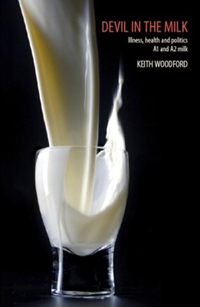Devil in the Milk
 Devil in the Milk
Devil in the Milk
Keith Woodford
Craig Potton Publishing
2007 (updated 2010)
ISBN: 9781877333705
NZ$34.99
257 pp, including index
Most people in Australia, New Zealand, North America and Europe drink cow’s milk, some in large quantities and many from an early age. What Prof Woodford writes about in this book should therefore be of concern to hundreds of millions of people. It is a story of research, business, government and vested interests. Those whose interests seem to be least considered in the way milk is presented to us are the consumers of the milk.
Although I suggest that you read the book for yourself for its clarity and detail, I will give a summary of the issues it deals with. Keith Woodford is Professor of Farm Management and Agribusiness in New Zealand. He explains and expands on broadly two types of bovine milk: A1 and A2. Cows that produce A1 milk are descended from cows that around eight to ten thousand years ago went through a genetic mutation. A2 milk is the original, un-mutated variant.
The difference between the two types of milk is that in the A1 variant there is a substitution of an amino acid in a particular position on a casein (milk protein) molecule. This substitution can cause a seven-amino acid fragment to break off when digested. This fragment, known as beta-casomorphone-7 (BCM7), has opioid (narcotic) properties and may be a factor in developing autism in susceptible individuals. It also appears to play a role in some auto-immune conditions, including Type 1 (early-onset) diabetes, as well as possibly causing arterial disease in later life. Prof Woodford presents compelling evidence for all of the above.
A2 milk is now readily available in Australia and New Zealand. The relevant gene that is responsible for the A1 variant is co-dominant with the original A2 variant, as a result of which cows produce 100% A2 milk or 50% of both A1 and A2 milk or 100% A1 milk. Because of this, it is straightforward to breed cows to produce 100% A2 milk and, therefore, to breed entire herds to do so; consequently, it is possible to create a supply of pure A2 milk. Theoretically this would be possible around the world and it would be feasible to breed out the A1-producing cows entirely in about ten years. The material in this book seems to make that a logical choice and it would have huge beneficial health results. Even though the evidence supporting such a move has been clear and available for some seven years, it hasn’t happened and is unlikely to happen for some time. Why?
Devil in the Milk explains this clearly: commercial vested interests and government regulators apparently are more concerned with protecting the dairy industry than in protecting and improving people’s health. One of the main factors in this is Fontera, a company that controls more than half of the world trade in dairy products as well as over 90% of the New Zealand dairy industry and almost half of the Australia industry. It seems that Fontera does not want to allow the breeding out of A1 cows as this may have consumers questioning the safety of the milk they are currently drinking, which could lead to an overall drop in milk consumption which would, in turn, hurt Fontera’s profits.
It is shameful that so frequently our wellbeing is compromised in the interest of commercial enterprise. However, in the case of milk, we can use our ‘consumer power’ to purchase only A2 milk (available from all major Australian supermarkets and widely in New Zealand) and force the dairy industry to change. In countries where A2 milk is not marketed, consumers can demand that it be made available.
Prof Woodford has done a wonderful job at bringing together all the scientific, commercial and political elements of the story and presenting it in a straightforward and uncomplicated way. The reader needs no scientific or statistical knowledge, as none is assumed in the evidence presented and in the explanation and discussion of the evidence. I commend this book to anyone who is concerned with looking after their own health and that of their children and it should be compulsory reading for all doctors, dieticians, nutritionists, naturopaths and other healthcare practitioners.
© 2011 Daan Spijer
[to receive an email each time a new review is posted, email me: <daan [dot] spijer [at] gmail [dot] com>]
 CLICK HERE to download a formatted PDF of the above post
CLICK HERE to download a formatted PDF of the above post
 See more of Daan Spijer’s writing and his photos at Seventh House Communications
See more of Daan Spijer’s writing and his photos at Seventh House Communications